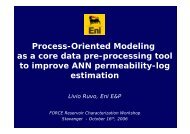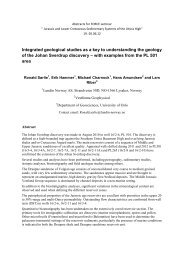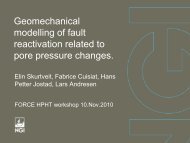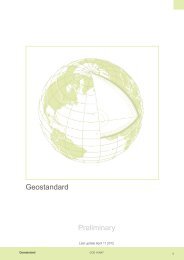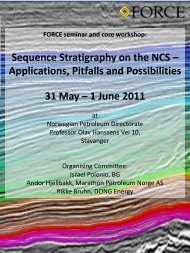Use of SBED as a tool for permeability modelling in ... - Force
Use of SBED as a tool for permeability modelling in ... - Force
Use of SBED as a tool for permeability modelling in ... - Force
You also want an ePaper? Increase the reach of your titles
YUMPU automatically turns print PDFs into web optimized ePapers that Google loves.
Petrophysical data analysis<br />
• We need to f<strong>in</strong>d <strong>permeability</strong>/porosity values <strong>for</strong> each lithotype (sand 1 & 2, mud…)<br />
• Not an e<strong>as</strong>y t<strong>as</strong>k …<br />
- There is typically a bi<strong>as</strong>ed data b<strong>as</strong>e sampl<strong>in</strong>g at the wrong volume (core plugs)<br />
- M<strong>in</strong>i-permeameter data are better, but rarely taken <strong>as</strong> standard …<br />
- Especially difficult to get <strong>permeability</strong> values <strong>for</strong> the mud layers<br />
• Key steps: Filter out “bi<strong>as</strong>ed plugs” that conta<strong>in</strong> multiple lithotypes<br />
Asses porosity and <strong>permeability</strong> distributions <strong>for</strong> the entire dat<strong>as</strong>et and <strong>for</strong> subsets:<br />
e.g. specific <strong>in</strong>tervals <strong>of</strong> NTG, depth <strong>in</strong>tervals …<br />
<strong>Use</strong> these results <strong>as</strong> a start<strong>in</strong>g po<strong>in</strong>t !<br />
M<strong>in</strong>i-perm<br />
Plug data<br />
Few data po<strong>in</strong>ts below 50%<br />
sand:shale ratio (essentially <strong>SBED</strong> submodel divisions)



